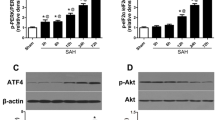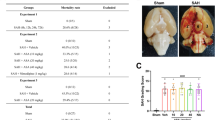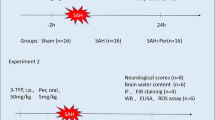Abstract
Background
AMP-activated protein kinase (AMPK) is a key metabolic and stress sensor/effector. Few investigations have been performed to study the role of AMPK in subarachnoid hemorrhage (SAH)-induced early brain injury (EBI). This study was undertaken to investigate the time course of AMPK activation in the early stage of SAH and to evaluate the influence of AICAR (which is known to mimic AMP and activates AMPK) and compound C (a commonly used AMPK inhibitor) on EBI in rats following SAH.
Methods
Adult male rats were divided into six groups: control, sham, SAH, SAH + vehicle, SAH + AICAR and SAH + compound C. SAHs were induced by a modified endovascular perforation method. Immunohistochemistry, real-time PCR and Western blot were used to detect the spatial and dynamic expression of AMPK after SAH. Cortical apoptosis and the expressions of apoptosis-related proteins such as FOXO3a (forkhead box, class O, 3a) and Bim (Bcl-2-interacting mediator of cell death) were detected after different drug interventions.
Results
We found SAH induced prolonged activation of AMPK. Treatment with AICAR markedly induced overactivation of AMPK and upregulation of FOXO3a and Bim. AICAR also significantly exacerbated cerebral apoptosis and neurological impairment following SAH. On the other hand, pre-administration of compound C attenuated EBI in this SAH model by modulating cerebral apoptosis by inhibiting FOXO3a and Bim.
Conclusions
Our findings suggest that the AMPK pathway may play an important role in SAH-induced neuronal apoptosis, and the use of AMPK inhibitors can provide neuroprotection in EBI after SAH.







Similar content being viewed by others
References
Whitfield J, Neame SJ, Paquet L, Bernard O, Ham J (2001) Dominant-negative c-Jun promotes neuronal survival by reducing BIM expression and inhibiting mitochondrial cytochrome c release. Neuron 29:629–643
Lee JY, He Y, Sagher O, Keep R, Hua Y, Xi G (2009) Activated autophagy pathway in experimental subarachnoid hemorrhage. Brain Res 1287:126–135
Sehba FA, Pluta RM, Zhang JH (2011) Metamorphosis of subarachnoid hemorrhage research: from delayed vasospasm to early brain injury. Mol Neurobiol 43:27–40
Hawley SA, Pan DA, Mustard KJ, Ross L, Bain J, Edelman AM, Frenguelli BG, Hardie DG (2005) Calmodulin-dependent protein kinase kinase-beta is an alternative upstream kinase for AMP-activated protein kinase. Cell Metab 2:9–19
Wu AG, Ying Z, Gomez-Pinilla F (2007) Omega-3 fatty acids supplementation restores mechanisms that maintain brain homeostasis in traumatic brain injury. J Neurotrauma 24:1587–1595
Biswas SC, Shi Y, Sproul A, Greene LA (2007) Pro-apoptotic Bim induction in response to nerve growth factor deprivation requires simultaneous activation of three different death signaling pathways. J Biol Chem 282:29368–29374
Greer EL, Oskoui PR, Banko MR, Maniar JM, Gygi MP, Gygi SP, Brunet A (2007) The energy sensor AMP-activated protein kinase directly regulates the mammalian FOXO3 transcription factor. J Biol Chem 282:30107–30119
Meley D, Bauvy C, Houben-Weerts JH, Dubbelhuis PF, Helmond MT, Codogno P, Meijer AJ (2006) AMP-activated protein kinase and the regulation of autophagic proteolysis. J Biol Chem 281:34870–34879
Poels J, Spasić MR, Callaerts P, Norga KK (2009) Expanding roles for AMP-activated protein kinase in neuronal survival and autophagy. Bioessays 31:944–952
Ronnett GV, Ramamurthy S, Kleman AM, Landree LE, Aja S (2009) AMPK in the brain: its roles in energy balance and neuroprotection. J Neurochem 109:17–23
Turnley AM, Stapleton D, Mann RJ, Witters LA, Kemp BE, Bartlett PF (1999) Cellular distribution and developmental expression of AMP-activated protein kinase isoforms in mouse central nervous system. J Neurochem 72:1707–1716
Li DY, Qu Y, Mao M, Zhang XL, Li JH, Ferriero D, Mu DZ (2009) Involvement of the PTEN-AKT-FOXO3a pathway in neuronal apoptosis in developing rat brain after hypoxia-ischemia. J Cerebr Blood F Met 29:1903–1913
Yatsushige H, Ostrowski RP, Tsubokawa T, Colohan A, Zhang JH (2007) Role of c-Jun N-terminal kinase in early brain injury after subarachnoid hemorrhage. J Neurosci Res 85:1436–1448
McCullough LD, Zeng Z, Li H, Landree LE, McFadden J, Ronnett GV (2005) Pharmacological inhibition of AMP-activated protein kinase provides neuroprotection in stroke. J Biol Chem 280:20493–20502
Davila D, Connolly NMC, Bonner H, Weisova P, Dussmann H, Concannon CG, Huber HJ, Prehn JHM (2012) Two-step activation of FOXO3 by AMPK generates a coherent feed-forward loop determining excitotoxic cell fate. Cell Death Differ 19:1677–1688
Weisova P, Concannon CG, Devocelle M, Prehn JH, Ward MW (2009) Regulation of glucose transporter 3 surface expression by the AMP-activated protein kinase mediates tolerance to glutamate excitation in neurons. J Neurosci 29:2997–3008
Weisova P, Davila D, Tuffy LP, Ward MW, Concannon CG, Prehn JHM (2011) Role of 5′-adenosine monophosphate-activated protein kinase in cell survival and death responses in neurons. Antioxid Redox Sign 14:1863–1876
Harris CA, Johnson EM Jr (2001) BH3-only Bcl-2 family members are coordinately regulated by the JNK pathway and require Bax to induce apoptosis in neurons. J Biol Chem 276:37754–37760
Germano AF, Dixon CE, Avella D, Hayes RL, Tomasello F (1994) Behavioral deficits following experimental subarachnoid hemorrhage in the rat. J Neurotrauma 11:345–353
Van Der Heide LP, Hoekman MF, Smidt MP (2004) The ins and outs of FoxO shuttling: mechanisms of FoxO translocation and transcriptional regulation. Biochem J 380:297–309
Brunet A, Bonni A, Zigmond MJ, Lin MZ, Juo P, Hu LS, Anderson MJ, Arden KC, Blenis J, Greenberg ME (1999) Akt promotes cell survival by phosphorylating and inhibiting a Forkhead transcription factor. Cell 96:857–868
Ren DC, Tu HC, Kim H, Wang GX, Bean GR, Takeuchi O, Jeffers JR, Zambetti GP, Hsieh JJD, Cheng EHY (2010) BID, BIM, and PUMA are essential for activation of the BAX- and BAK-dependent cell death program. Science 330:1390–1393
Kim EK, Miller I, Aja S, Landree LE, Pinn M, McFadden J, Kuhajda FP, Moran TH, Ronnett GV (2004) C75, a fatty acid synthase inhibitor, reduces food intake via hypothalamic AMP-activated protein kinase. J Biol Chem 279:19970–19976
Gilley J, Coffer PJ, Ham J (2003) FOXO transcription factors directly activate bim gene expression and promote apoptosis in sympathetic neurons. J Cell Biol 162:613–622
Concannon CG, Tuffy LP, Weisová P, Bonner HP, Dávila D, Bonner C, Devocelle MC, Strasser A, Ward MW, Prehn JH (2010) AMP kinase-mediated activation of the BH3-only protein Bim couples energy depletion to stress-induced apoptosis. J Cell Biol 189:83–94
Sharma S, Zhuang Y, Ying Z, Wu A, Gomez-Pinilla F (2009) Dietary curcumin supplementation counteracts reduction in levels of molecules involved in energy homeostasis after brain trauma. Neurosci 161:1037–1044
Towler MC, Hardie DG (2007) AMP-activated protein kinase in metabolic control and insulin signaling. Circ Res 100:328–341
King TD, Song L, Jope RS (2006) AMP-activated protein kinase (AMPK) activating agents cause dephosphorylation of Akt and glycogen synthase kinase-3. Biochem Pharmacol 71:1637–1647
Culmsee C, Monnig J, Kemp BE, Mattson MP (2001) AMP-activated protein kinase is highly expressed in neurons in the developing rat brain and promotes neuronal survival following glucose deprivation. J Mol Neurosci 17:45–58
Meisse D, Van de Casteele M, Beauloye C, Hainault I, Kefas BA, Rider MH, Foufelle F, Hue L (2002) Sustained activation of AMP-activated protein kinase induces c-Jun N-terminal kinase activation and apoptosis in liver cells. FEBS Lett 526:38–42
Bederson JB, Germano IM, Guarino L (1995) Cortical blood flow and cerebral perfusion pressure in a new noncraniotomy model of subarachnoid hemorrhage in the rat. Stroke 26:1086–1091
Li J, Benashski S, McCullough LD (2011) Post-stroke hypothermia provides neuroprotection through inhibition of AMP-activated protein kinase. J Neurotrauma 28:1281–1288
Li J, Zeng Z, Viollet B, Ronnett GV, McCullough LD (2007) Neuroprotective effects of adenosine monophosphate-activated protein kinase inhibition and gene deletion in stroke. Stroke 38:2992–2999
Tzatsos A, Tsichlis PN (2007) Energy depletion inhibits phosphatidylinositol 3-kinase/Akt signaling and induces apoptosis via AMP-activated protein kinase dependent phosphorylation of IRS-1 at Ser-794. J Biol Chem 282:18069–18082
Acknowledgments
This study was supported by the National 863 Project of China, no. 2006AA02Z4Z4; the National Natural Science Foundation of China, no. 30870844; the New Century Excellent Talent Support Project of Ministry of Education, no. NCET-05-0831; the “13115” Special Fund for Major Science and Technology Projects of Shaanxi Province, no. 2008ZDKG-66
Conflicts of interest
None.
Author information
Authors and Affiliations
Corresponding author
Additional information
Ji-Yang An and Li-Li Zhou contributed equally to this work and should be considered co-first authors
Rights and permissions
About this article
Cite this article
An, JY., Zhou, LL., Sun, P. et al. Role of the AMPK signaling pathway in early brain injury after subarachnoid hemorrhage in rats. Acta Neurochir 157, 781–792 (2015). https://doi.org/10.1007/s00701-015-2370-3
Received:
Accepted:
Published:
Issue Date:
DOI: https://doi.org/10.1007/s00701-015-2370-3




